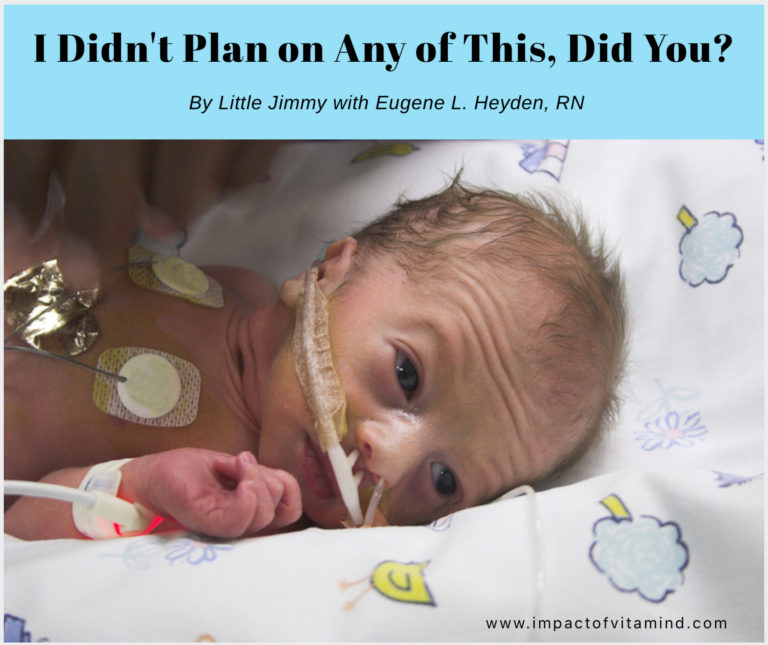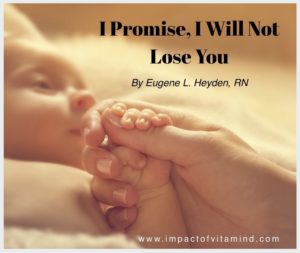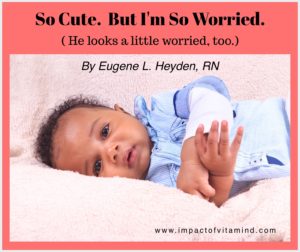I Didn’t Plan on Any of This, Did You?

Last update: 12-13-23
By Little Jimmy with Eugene L. Heyden, RN
Do I look like I am particularly happy? I think not. I’m struggling here, and none of this should have ever happened. I was born premature; not by design, not because I am defective, but perhaps due to ignorance or neglect. If only my mommy had known, if only the doctor had known, it was an easily manageable problem that shoved me out into this world weeks before I was ready, then corrective action could have been taken and we would not be having this little conversation. It was vitamin D deficiency that placed my life in jeopardy. I’m just sure of it! I’ve looked at the evidence. (Do I look like I have anything better to do?)
“Vitamin D insufficiency has been associated with a number of adverse pregnancy outcomes, and has been recognized as a public health concern.” (Bener et al., 2013)
As I write, I am going to go a little hard on the doctor. He is so nice and caring. He is also very smart, and has a terrific, expensive education. But he has been listening to the voice of those who teach that we really don’t need to pay close attention to the vitamin D status of mothers-to-be. “They’re probably getting plenty, is the thought. It’s in their prenatal vitamin. It’s in dairy products. It’s in orange juice. Plus, they’re probably getting some vitamin D from sunlight exposure. So, I’m sure they are getting enough.” Wanna bet?
“The vitamin D-deficiency epidemic during pregnancy is caused by a lack of adequate sunlight exposure needed to synthesize vitamin D in the skin, coupled with overall intakes that are too low to meet the increased demands of pregnancy.” (Berner et al., 2013)
“It is well known that vitamin D deficiency is prevalent among pregnant women and pregnant women have significantly lower levels of 25(OH)D than nonpregnant control women. Approximately two in three pregnant women in the United States have suboptimal vitamin D status, with an even higher prevalence among black and Mexican-American women.” (Lerchbaum and Obermayer-Pietsch, 2012, emphasis added)
“Vitamin D is important to maternal health, fetal development, and postnatal life. Current prenatal care does not include the monitoring of vitamin D levels, which is an unfortunate oversight because deficiency is easily treated.” (Mulligan et al., 2010)
The truth is vitamin D sufficiency is an individual matter. A simple blood test could have revealed that Mommy was indeed vitamin D deficient, very deficient, placing me at great risk. In fact, I could have died. … Oh, no! I just noticed little Susie, over there in the corner incubator, didn’t make it. The cries of her patents are so painful to hear. Her nurse is crying, too. Did Susie die because of maternal vitamin D deficiency? Maybe. Likely. After a moment of silence for Susie, we will continue.
[Silence]
Now, where were we? Oh! We were talking about Mommy, me, and vitamin D. (Has a nice ring to it, don’t you think?) Unfortunately for me, my mommy did not receive that necessary blood test and definitive treatment, and I was allowed to go through gestation vitamin D deficient. This put both of our lives at risk, Mommy and me. And did I have a cord blood vitamin D level drawn at birth to see if I was vitamin D deficient? No. And did I get a vitamin D level drawn at any time in my short little life? No. So, I am a little upset with the standard of care in Medicine right now. I guess Medicine is a little worried about spending the fifty bucks a vitamin D level would cost but doesn’t mind spending the $41,610 or more on my NICU care. Now listen up:
“Preterm birth is . . . most commonly caused by infection and inflammation. Vitamin D, acting as an immune modulator, can reduce the possibility of preterm birth by inhibiting inflammation and regulating immune function.” (Qin et al., 2016)
“In recent studies we have shown that vitamin D is a potent stimulator of innate antimicrobial responses to infection in human placental cells, whilst simultaneously inhibiting inflammation and risk of preterm birth.” (Grayson and Hewiston, 2011)
But it was not infection and inflammation that put me in this predicament, at least I don’t think so. It was “preeclampsia.” (I overheard someone say this.) In case you don’t know,
“Preeclampsia, as identified by new onset hypertension [high blood pressure] and proteinuria [protein spilling into the urine] during pregnancy is a serious disorder affecting 5–8% of pregnancies, and is alleviated only by delivery of the placenta.” (Shin et al., 2010)
I guess under the cloud of preeclampsia I am lucky to have make it this far. Preeclampsia deprived me of adequate oxygen and nutrients, as well as a safe place to develop. It causes all sorts of trouble, and both my life and the life of my dear mommy could have ended due to preeclampsia. “Recent evidence suggests that preeclampsia accounts for approximately 15.9% of all maternal deaths in the United States and is a major cause of perinatal morbidity and mortality.” (Backe et al., 2011). But thanks to the great care Mommy has received, my chance of survival is very good. And the level of care I am receiving in the NICU is outstanding. But I didn’t want this great care! I was shooting for a normal, term birth. I was aiming for a better chance of survival. And I will survive, I just know it. I have a bright future ahead. I’ll probably go into vitamin D research and advocacy.
And speaking of vitamin D research, I was surprised to learn that according to one study, “patients with 25(OH)D levels 15 ng/mL [quite low, but common] had a 5-fold increase in the risk of preeclampsia, despite receiving prenatal vitamins.” (Mulligan et al., 2010, emphasis added) Other studies have found pretty much the same thing. For example:
“In a recent study, the odds of severe preeclampsia decreased by 38% for every 10 nmol/L increase in 25(OH)D [vitamin D].” (Christensen et al., 2012)
“Almost all cross-sectional studies have reported a significant association between vitamin D deficiency and risk of pre-eclampsia.” (Tabesh et al., 2013)
“Women with vitamin D deficiency (<20 ng/ml) were more likely to have low levels of placental growth factor, which is associated with an increased risk of preeclapsia.” (Fanos et al., 2013)
All this preeclampsia! All this risk! And some of this is so easily preventable.
“Vitamin D deficiency is often clinically unrecognized, however laboratory measurements are easy to perform, and treatment of vitamin D deficiency is inexpensive.” (Grundermann and von Versen-Höynck, 2011)
I think I can bring this article to a close, now that I have your attention. If you are pregnant or want to get pregnant, I have confidence you will not rely on your prenatal vitamin to provide you with an adequate amount of vitamin D. That would be ridiculous. “In the United States, 25(OH)D3 concentrations are surprisingly low during pregnancy, despite some supplementation with prenatal vitamins.” (Patrick and Ames, 2014) I’ll bet you will demand a vitamin D level test along with therapy that will raise your vitamin D level into a respectable range. And not just once during your pregnancy, but several times along the way. Of course, you will faithfully take your vitamin D, as prescribed. You will certainly question small-dose vitamin D replacement, knowing that you most likely need several thousands of units of supplemental vitamin D per day to become vitamin D sufficient, rather than the hundreds of units per day that is so often recommended and so often ineffective. Now, if you are a physician, I hope you will stop listening to the voices of those who keep telling you that all is well. It is not! Babies, even mothers, are lost and damaged due to neglect and inattention to the individual vitamin D status of the mother-to-be. And I feel I should say this:
Should you disagree or be offended by with any of this, please don’t be too hard on my coauthor. These are my words, not his (he just helped me with the spelling). By all accounts, he is a very nice guy. He once wrote: “I want to spare babies. I want to spare children. I have nothing better to do. There is nothing better to do!” (Heyden, 2014, emphasis added) I really like this guy. I think he just wants to prevent heartache and loss of life.
Let me close with this:
“Vitamin D deficiency during pregnancy is the origin of a host of future perils for the child. Some of this damage done by maternal vitamin D deficiency becomes evident after many years. Therefore, prevention of vitamin D deficiency among pregnant women is essential. The current recommended supplementation amount of vitamin D is not sufficient during pregnancy. ” (Kaushal and Magon, 2013)
Related posts (Click on image to open)
References
Backes CH, Markham K, Moorehead P, Cordero L, Nankervis CA, Giannone PJ 2011 Maternal Preeclampsia and Neonatal Outcomes. Journal of Pregnancy. Apr 4
Bener A, Al-Hamaq A OAA, Saleh NM 2013 Association Between Vitamin D Insufficiency and Adverse Pregnancy Outcome: Global Comparisons. International Journal of Women’s Health 5:523–531
Christensen HT, Falkenberg T, Lamont RF, Jørgensen JS 2012 The Impact of Vitamin D on Pregnancy: A Systematic Review. ACTA Obstetrica et Gynecologica 91(2012):1357–1367
Fanos M, Vierucci F, Saggese G 2013 Vitamin D in the Prenatal Period: An Update. Journal of Pediatric and Neonatal Individualized Medicine 2(2):e020202
Grayson R, Hewison M 2011 Vitamin D and Human Pregnancy. Food and Maternal Medicine Review 22(1):67–90
Grundmann M, von Versen-Höynk F 2011 Vitamin D—Roles in Women’s Reproductive Health? Reproductive Biology and Endocrinology 9:146
Heyden EL 2014 Mommy, Me, and Vitamin D. Impact Health Publishing Spokane, WA USA (ISBN: 978-0-9828276-3-5)
Kaushal M, Magon N 2013 Vitamin D in Pregnancy: A Metabolic Outlook. Indian J Endocrinol Metab; January–February; 17(1):76–82
Lerchbaum E, Obermayer-Pietsch B 2012 Vitamin D and Fertility: A Systematic Review. European Journal of Endocrinology 166:765–778
Mulligan ML, Shaili SK, Riek AE, Bernal-Mizrachi C 2010 Implications of Vitamin D Deficiency in Pregnancy and Lactation. Am J Obstet Gynecol; May; 202(5):429.e1–429.e9
Patrick RP, Ames BN 2014 Vitamin D Hormone Regulates Serotonin Synthesis. Part 1: Relevance for Autism. FASEB J 28 [Epub ahead of print]
Qin LL, Lu FG, Yang SH, Xu HL, Luo BA 2016 Does Maternal Vitamin D Deficiency Increase the Risk of Preterm Birth: A Meta-Analysis of Observational Studies. Nutrients. May 20; 8(5):301.
Shin JS, Choi MY, Longtine MS, Nelson DM 2010 Vitamin D Effects on Pregnancy and the Placenta. Placenta 31(12):1027–1034
Tabesh M, Salehi-Abargouei A, Tabesh M, Esmaillzadeh A 2013 Maternal Vitamin D Status and Risk of Pre-eclampsia: A Systematic Review and Meta-analysis. The Journal of Clinical Endocrinology & Metabolism. Jun 19; 98(8):3165–3173.
Disclaimer: This article is presented solely for informational purposes. The information contained herein should be evaluated for accuracy and validity in the context of opposing data, new information, and the views and recommendations of a qualified health care professional, and not to be substituted for professional judgment and guidance or to provide a reason to neglect or delay appropriate medical care. It is the reader and reader only who bears the responsibility for any actions that could be construed as being a response to the information contained herein. The statements and opinions expressed by the author have not been reviewed or approved by the FDA or by any other authoritative body, nor is the author endorsing any product or specific therapy. This article is offered to the reader to broaden his or her understanding of the issues discussed and to help identify options that may be suitable for the individual to pursue, on behalf of self or others, under approval and direction of a qualified physician. The author and publisher offer no guarantees of the accuracy or validity of the quotations incorporated into this article or the accuracy or validity of the information presented by the resources that are herein recommended.
Copyright © 2016–2023 Eugene L. Heyden, RN
All Rights Reserved




